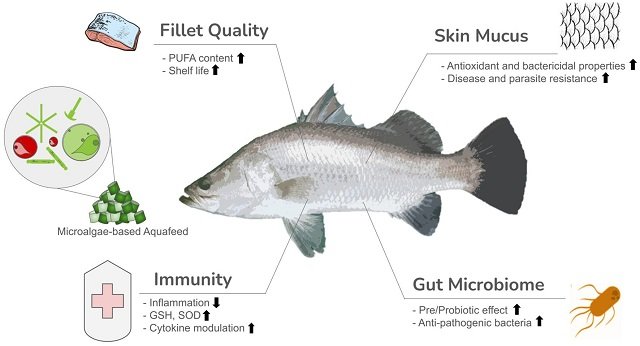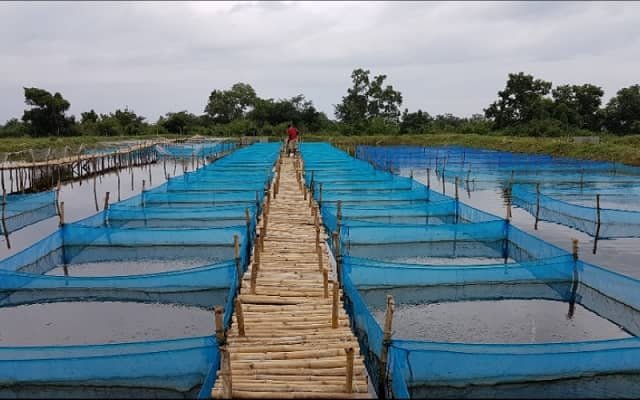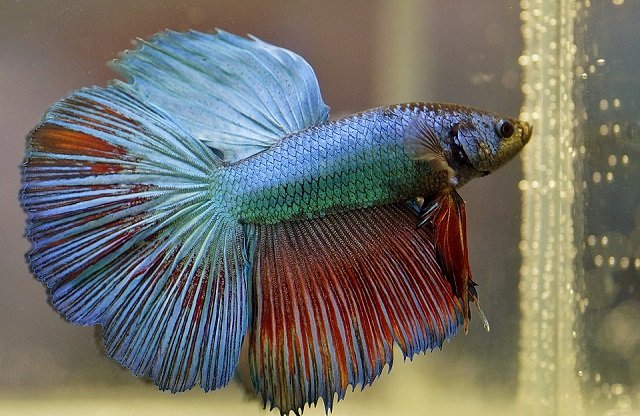
The growth of the aquaculture industry faces a critical challenge: the dependency on fishmeal and fish oil, which are finite, costly resources whose exploitation jeopardizes the sector’s sustainability.
A recent review article published in Frontiers in Marine Science by scientists from the University of Technology and the New South Wales Department of Primary Industries explores one of the most promising alternatives: marine microalgae. This work not only highlights their nutritional potential but also delves into the biotechnological advances that could make microalgae a key and cost-effective ingredient in the aquafeed of the future.
Why are microalgae a superior alternative?
For years, the industry has explored alternatives to fishmeal, such as soybean or insect meal. While some are functional, they often have disadvantages: they compete for arable land, introduce anti-nutritional factors, or lack essential fatty acids.
Microalgae, in contrast, offer a unique package of benefits:
- Sustainability: Microalgae cultivation does not compete for arable land and can be carried out in saline waters or even in aquaculture effluents, promoting a circular economy.
- Complete nutritional profile: They are primary producers of essential compounds such as omega-3 fatty acids (EPA and DHA), amino acids, vitamins, and pigments not found in terrestrial alternatives.
- Health benefits: The bioactive compounds in microalgae improve immune function, disease resistance, and the final quality of the fillet, providing added value that goes beyond simple nutrition.
The study delves into the three nutritional pillars that make microalgae a “superfood” for fish.
High-quality proteins
The cost of protein is the main factor in aquafeed production. Microalgae contain all the essential amino acids that fish need, with profiles comparable or even superior to those of traditional sources like eggs. Species like Arthrospira (spirulina) can reach up to 65% protein. However, the article warns about the importance of standardizing quantification methods, as the traditionally used nitrogen conversion factor (N×6.25) can overestimate the actual protein content in microalgae, with the factor N×4.78 being more accurate.
Lipids and the valuable omega-3s (EPA and DHA)
Fish oil is a high-value product (approximately 7,700 USD/tonne), and its substitution with vegetable oils can compromise the fish’s health and the nutritional benefits for the end consumer. Microalgae are among the few organisms capable of synthesizing EPA and DHA de novo, positioning them as the ideal sustainable alternative to fish oil. By optimizing cultivation conditions, the lipid content can be increased to up to 70% of the dry weight.
Bioactives: beyond basic nutrition
This is perhaps one of the biggest differentiators. Microalgae are rich in compounds with antioxidant, anti-inflammatory, and immunostimulant properties.
Stay Always Informed
Join our communities to instantly receive the most important news, reports, and analysis from the aquaculture industry.
- Natural antioxidants: The sector uses synthetic antioxidants like BHT and BHA to preserve feeds, but there are growing concerns about their safety and toxicity for fish and the environment. Microalgae offer a natural and safe alternative.
- Carotenoids (Astaxanthin): Astaxanthin is a potent antioxidant that also provides the desired reddish color in species like salmon and trout. Natural astaxanthin from microalgae such as Haematococcus pluvialis is more bioavailable and effective than its synthetic counterpart derived from petrochemicals.
- Polyphenols: These compounds have a remarkable antiviral and antioxidant capacity, helping fish fight pathogens and reduce inflammatory stress.
Biotechnology: the key to optimizing the use of microalgae
Despite their benefits, the large-scale integration of microalgae has been limited by their high production cost, which can be 5 to 10 USD/kg compared to 2.20 USD/kg for fishmeal. This is where biotechnology plays a decisive role.
Strain selection and bioengineering
Not all microalgae are the same. Research focuses on selecting strains with the best nutritional profiles for specific fish species (carnivorous, herbivorous, or omnivorous).
Furthermore, techniques such as Adaptive Laboratory Evolution (ALE) are being used. This method subjects microalgae to controlled stress conditions (like high salinity or specific light) over generations to “train” them and naturally enhance the production of target metabolites, such as carotenoids or lipids, without resorting to genetic modification, thus avoiding regulatory and ethical barriers.
Advances in production and processing
To reduce costs, advances are being implemented throughout the entire process:
- Biorefineries: Integrating production and processing in a single automated location, using artificial intelligence to optimize cultivation conditions and recycle resources like CO2, increases efficiency and economic viability.
- “Green hydrolysis” methods: For the nutrients in microalgae to be digestible, their cell walls must be broken down. Instead of costly chemical or thermal methods, treatments with bacteria that perform biological hydrolysis during fermentation are being investigated, which is a more economical and sustainable method.
The path forward: from a cost to a functional investment
The study concludes with a realistic yet optimistic perspective. While the price per kilogram of microalgae remains an obstacle, the analysis should not stop there.
Incorporating a functional food like microalgae can reduce costs associated with diseases, parasites, and mass mortalities, thanks to the direct improvement in the immune system and general well-being of the fish. This functional benefit could more than offset the higher initial feed cost.
For this transition to be successful, the article underscores the need to standardize the reporting of nutritional parameters (phenolic content, antioxidant capacity, etc.) to allow for reliable comparisons and facilitate their adoption by the industry.
Ultimately, biotechnological advances are paving the way for microalgae to cease being a niche ingredient and become a pillar of aquaculture nutrition: a sustainable, regenerative, and high-functional-value solution for the future of fish production.
Reference (open acces)
Tierney, J., Ralph, P. J., Pirozzi, I., & Pernice, M. (2025). Harnessing microalgae for finfish nutrition: Advances in biotechnology and aquafeed development. Frontiers in Marine Science, 12, 1611271. https://doi.org/10.3389/fmars.2025.1611271
Editor at the digital magazine AquaHoy. He holds a degree in Aquaculture Biology from the National University of Santa (UNS) and a Master’s degree in Science and Innovation Management from the Polytechnic University of Valencia, with postgraduate diplomas in Business Innovation and Innovation Management. He possesses extensive experience in the aquaculture and fisheries sector, having led the Fisheries Innovation Unit of the National Program for Innovation in Fisheries and Aquaculture (PNIPA). He has served as a senior consultant in technology watch, an innovation project formulator and advisor, and a lecturer at UNS. He is a member of the Peruvian College of Biologists and was recognized by the World Aquaculture Society (WAS) in 2016 for his contribution to aquaculture.




